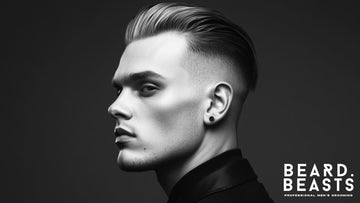How to Style and Enhance a Thin Beard
Welcome to the comprehensive guide on navigating the world of thin beards. Whether you're experiencing beard thinning or naturally have a thin beard, this article is designed to provide you with essential insights and practical tips to enhance your beard's appearance.
From understanding the factors that contribute to a thin beard to discovering the best styles for thin beards and debunking common myths, we'll cover everything you need to know to make the most of your facial hair.
Our goal is to help you embrace your unique beard, offering advice on grooming, maintenance, and styling to ensure your beard looks its best.
Get ready to transform the way you see and care for your thin beard, armed with knowledge and confidence.

Understanding Your Thin Beard
When it comes to nurturing a beard, many find themselves grappling with a thin or patchy appearance. If you're aiming to achieve a fuller look, it's crucial to delve into the root causes behind a thin beard.
Genetics and Thin Beards
The foundation of your beard's density and growth pattern is largely written in your DNA. If your ancestors sported lush beards, chances are higher you might too. However, genetics can also be the reason behind a thinner beard, dictating how each hair follicle responds to hormonal signals. It's essential to recognize that, despite genetic predispositions, there are ways to enhance your beard's appearance.
Health and Lifestyle Factors
Your daily habits play a significant role in the health and thickness of your beard. A diet rich in vitamins and minerals, such as vitamins A, B, C, E, and zinc, can foster healthier beard growth. Regular exercise boosts overall health and increases blood circulation, which aids in nutrient delivery to your hair follicles. Don't underestimate the power of good sleep; it's when your body repairs itself, impacting beard health directly.
Hormonal Influences
The hormones testosterone and dihydrotestosterone (DHT) are key players in facial hair development. Low levels of these hormones can result in beard thinning or slow growth. Testosterone is converted to DHT, which then interacts with hair follicles to promote beard growth. Enhancing your lifestyle to support hormonal balance—such as reducing stress, getting adequate sleep, and maintaining a balanced diet—can indirectly contribute to a fuller beard.
In summary, while genetics set the stage for your beard's potential, health and lifestyle factors, along with hormonal balances, are the actors that determine its growth and fullness. Embracing the best styles for thin beards, understanding beard thinning, and adopting a healthy lifestyle can make a significant difference in your beard's appearance. Remember, each facial hair is unique; celebrating and working with what you have can lead to impressive results and a style that suits you best.
Essential Tips for Growing a Thicker Beard
Achieving a thicker beard is a common goal for many, but it often requires a bit of effort and dedication. If you're looking to transform your thin beard into a fuller, more robust facial feature, here are some essential tips that can guide you on your journey.
Optimizing Your Diet
The saying "you are what you eat" rings true when it comes to beard growth. For a healthier, thicker beard, your diet should be rich in specific nutrients and vitamins. Focus on foods high in proteins, such as chicken, fish, eggs, and legumes, as these are the building blocks of hair. Vitamins A, B, C, and E, along with minerals like zinc and iron, play critical roles in hair growth and repair. Incorporating a variety of fruits, vegetables, nuts, and whole grains into your meals can lay the foundation for a denser beard.
Effective Grooming Habits
Proper beard grooming is crucial for encouraging a thicker beard. Begin with a regular washing routine to keep your beard clean and free from dead skin cells. Use a mild beard wash to avoid stripping away natural oils that moisturize and nourish your beard hair. After washing, apply a beard oil or balm to keep your facial hair hydrated and manageable. Regular trims, even when growing your beard, can help eliminate beard split ends and encourage healthy growth.
Remember, grooming is not just about the products you use but also about maintaining the health of your skin underneath.
Exercise and Beard Growth
Physical activity is beneficial for more than just your physique; it can also boost your beard growth. Exercise, particularly strength training, can increase testosterone levels, which is vital for facial hair growth. Activities like weightlifting, HIIT workouts, and even brisk walking or cycling can help enhance blood flow, ensuring that your hair follicles get the nutrients they need to thrive. Aim for a balanced workout routine that includes both cardiovascular and strength training exercises for the best results.
In weaving these tips into your daily routine, you're not just working towards a thicker beard but also improving your overall health and well-being. Whether it's optimizing your diet, establishing effective grooming habits, or incorporating regular exercise, each step brings you closer to achieving the fuller, healthier beard you desire. Remember, patience and consistency are key; with time, your efforts will likely pay off, allowing you to explore various styles for thin beards and embrace a more confident look.
Grooming Techniques for a Fuller Look
Crafting a fuller appearance for your thin beard can be achieved with the right grooming techniques. By focusing on trimming strategies, utilizing styling products, and maintaining a consistent beard care routine, you can enhance the look of your beard, making it appear denser and more voluminous.





